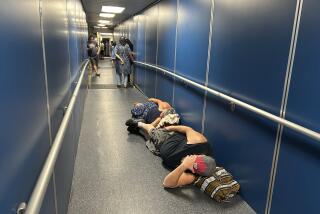When the Messages Stop
- Share via
Tripped up by the nation’s most dramatic satellite communications failure to date, millions of Americans on Wednesday were forced to abandon their pagers in favor of mobile phones, e-mail and plain old telephone lines to keep in touch as paging and other companies scrambled to find backup satellites.
The outage aboard the Galaxy 4 satellite, which began shortly after 3 p.m. Tuesday, rippled across the country, affecting everyone from doctors to real estate agents, from traders on the Chicago Board of Trade to basketball fans tuning in to a playoff game.
The ailing satellite, which engineers have not been able to repair, continued to spin safely--but uncontrollably--in its orbit 22,300 miles above Kansas. The $250-million spacecraft, built by Hughes Space & Communications in El Segundo, is part of a 17-satellite constellation run by PanAmSat Corp. in Connecticut.
In a demonstration of the reach of satellites into the nation’s economy, the failure extended far beyond pagers. It disrupted news operations such as National Public Radio, countless radio stations and a wide range of businesses that use the satellite for credit card and check-verification systems at gas stations, department stores and supermarkets.
A large number of private corporate networks--including those used by Ford Motor Co., Microsoft Corp., Xerox Corp., Eli Lilly & Co. and New York Life Insurance Co.--also send information through the crippled satellite, according to the Westsat Satellite Channel Chart, an industry newsletter published in Pleasanton, Calif.
Many of those corporate networks are run by Hughes Network Systems of Maryland, which said it has about 20,000 individual antennas aimed at the Galaxy 4 and serving about 11,000 corporate customers in North America.
Although the episode might seem to put a black eye on the communications satellite industry, one spokesman sounded almost pleased by all the attention.
“This highlights how important satellites are to the core fabric of the entire telecommunications infrastructure in the United States,” said Harry Thibedeau, manager for industry affairs at the Satellite Broadcasting and Communications Industry, a trade group based in Virginia. “I bet most people until [Tuesday] didn’t know satellites had anything to do with their pager.”
Indeed, the most widespread effect of the outage was on the country’s fast-growing paging networks, rendering the devices useless for an estimated 90% of the 49.5 million customers in the U.S. Ground-based paging networks were not affected.
Many of the largest companies began restoring service city by city Wednesday, but several paging operators estimated it would take from 48 hours to several days to reestablish service throughout their networks.
Nearly all major paging companies--including Paging Network, PageMart, AirTouch Paging, SkyTel, Arch Communications, MetroCall and others--were switching their systems to another satellite nearby and individually repositioning tens of thousands of ground stations to align them with the new satellite.
“Recognizing the importance of pagers in people’s lives, our employees are working around the clock to restore service to our customers,” said Charlie Jackson, president of AirTouch Paging, which has more than 3 million paging customers.
Dallas-based PageNet, the nation’s largest operator, with 10.4 million customers, said more than 40% of its customers had working pagers by Wednesday afternoon. The company expects to boost that number to 60% overnight and to 90% by Friday morning.
“Southern California’s probably our single biggest market, and we don’t have solid coverage there yet,” said Scott Baradell, a PageNet spokesman. “In a place like L.A., there are a lot of transmission sites to get to.”
Several TV networks, including Spanish-language Telemundo and others, transmit signals through Galaxy 4, but they had backup plans ready and switched to other satellites without interrupting broadcasts.
“It caused a lot of people to scramble, but we were prepared,” said Don Tringali, executive vice president of the Telemundo network, which includes the Los Angeles affiliate KVEA-Channel 52. “Our programming was not affected.”
But not all radio and TV broadcasters could act fast enough. In the Midwest, scores of affiliates of Network Indiana lost their radio feed of Tuesday’s basketball playoff game between the Indiana Pacers and the Chicago Bulls.
PanAmSat, the company at the heart of the chaos, was rapidly moving its paging and some other customers to a nearby satellite, Galaxy 3-R. In addition, PanAmSat plans to move its Galaxy 6 satellite to the wounded satellite’s position--a six-day process--to take over much of the traffic normally sent through Galaxy 4.
The company said it still does not know why the positioning equipment--and the backup system--failed on the 5-year-old Galaxy 4. PanAmSat has ruled out sabotage and damage from a collision with space debris.
In a recent government filing, PanAmSat reported some mechanical problems with Galaxy 4, but company officials said those were not related to Tuesday’s outage. PanAmSat said the satellite is insured for $160 million and is worth as much as $250 million, including the cost of its launch and insurance.
“Middle-aged guys drop dead of heart attacks, but it’s not often that middle-aged satellites konk out,” said John Pike, director of space policy at the Federation of American Scientists. “But it does happen, and this one just happened to have 90% of the nation’s pagers on it.”
Observers said paging companies preferred the Galaxy 4 because its power and its position--over Kansas--gave carriers widespread U.S. coverage. The outage was made worse by the fact that many paging companies forgo backup satellite capacity because of the high cost and the rarity of mishaps.
“This has never happened before in 35 years,” said Fred Landman, president of PanAmSat. “When things never happen, redundancy and backup capacity is not the first and foremost concern.”
* HIGH ANXIETY: Outage points up the fragility of telecom infrastructure. A1
* A FEW POINTERS: What consumers can expect in the next few days. D4
(BEGIN TEXT OF INFOBOX / INFOGRAPHIC)
Lost in Space
PanAmSat Corp.’s Galaxy 4 satellite stopped providing paging service to roughly 90% of subscribers in the United States when it began an uncontrollable spin and was unable to receive signals from regional towers. Satellites are an integral part of a paging company’s network, allowing it to beam its signals all over the United States at once. The number of Americans using pagers has exploded in the last 10 years. How a pager works and the number of subscribers in the United States:
How a Pager Works
1. The person placing a page dials the pager’s phone number. The signal gets a special code so it knows which pager it’s intended for.
2. The page travels through the telephone network to a paging terminal, where it’s beamed through the atmosphere.
3. The satellite picks up the signal and beams it back down to transmitters in the paging company’s service area.
4. The transmitters blanket the service area with the page.
5. The appropriate pager recognizes the signal and displays the message on its screen.
Number of Pager Subscribers
In millions (Figures for 1998 through 2001 are estimates)
2001: 66.5 million
Sources: Personal Communications Industry Assn., Times research
Researched by JENNIFER OLDHAM / Los Angeles Times
More to Read
Inside the business of entertainment
The Wide Shot brings you news, analysis and insights on everything from streaming wars to production — and what it all means for the future.
You may occasionally receive promotional content from the Los Angeles Times.










